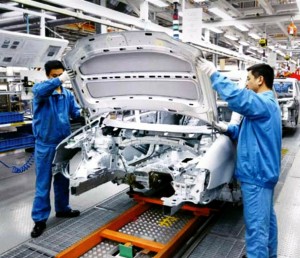
Workers at a Volkswagen plant, in Shanghai, struggle to keep up with a market that barely felt the impact of the global economic meltdown.
U.S. sales numbers for October are due out, starting today, and initial indications suggest it could be one of the first reasonably good months – without federal assistance from the Clunkers program – since the economy began its meltdown.
But while the American market is expected to struggle for some time to come, it’s a very different story, halfway ‘round the world. China already has surged to the global sales lead, surpassing the States as the globe’s single-biggest national car market. And, if anything, demand is only growing.
Sales for the first nine months of 2009 have exceeded all of 2008, according to the latest analysis by J.D. Power and Associates, and there is little likelihood momentum will slip in the final months of the year.
Where even a single-digit gain is big news in the States, September sales, in China, were up an astounding 75%, to 1.26 million. On an annualized basis, that averages out to 14.9 million vehicles. And if the growth rate continues, it’s very possible the Chinese market could soon match the best-ever, 17-million numbers set in the U.S. earlier this decade. A far greater share, however, is made up of commercial vehicles, than in the States. Power is predicting that on the passenger vehicle side, sales next year will jump 4.6%, to 8.8 million, and that’s expected to reach 12 million by 2016.
A decade ago, commercial vehicles were a major source of business for Chinese vehicle manufacturers; while government and senior business leaders dominated the passenger car side. The emergence of a middle-class car market has fueled the country’s explosive growth. But Power finds “another positive indicator for the China economy (in) the upturn in medium and heavy commercial vehicles,” which shows the resilience of the country’s manufacturing sector, among other things.
Of course it helps that China’s third-quarter GDP growth was 8.9%, nearly triple the figures that convinced analysts the U.S. had sluggishly pulled out of a formal recession. For the year, as a whole, reports Power, Chinese GDP should be up 8%.
Another significant shift is the spreading of the auto boom to inner Chinese provinces. Until recently, the country’s economic miracle has largely been confined to the key provinces that form a crescent along the Pacific coast – and especially in big cities like Shanghai and Beijing.
Suddenly, says a new Power report, “Registration data shows that passenger vehicle sales grew the fastest in the inner provinces such as Sichuan, Henan, Shaanxi, Jiangxi and Gansu.” But the report points out that these regions of the country “has been stimulated by government policy.”
Beijing has taken an active role in spurring the country’s critical automotive market, using financial carrots and sticks, including measures to shift demand towards smaller, more fuel-efficient vehicles, this year.
“Looking ahead to government incentives in 2010,” Power forecasts, “there is an early indication that the government will add a scrap incentive program next year,” though other sources suggest it will be more like European programs than the American Cash-for-Clunkers effort.
And while older Chinese vehicles are more likely to be true clunkers than American models of a similar age, there are far fewer of them on the road. But the government is pushing to clean up emissions at an aggressive rate, so considering its belated move to enact strict exhaust standards, a scrappage program could have a significant impact.
So far, China’s automotive boom has largely been internal. The question is what happens if manufacturers start targeting the world beyond the old Bamboo Curtain? We may soon get a sense of the possibilities, what with GM selling Hummer to a previously small Chinese firm and Ford negotiating the sale of Volvo to another.
Power’s report notes that the odds of success for Geely are “intimidating,” but that the firm may be better-positioned than skeptics suggest. For one thing, “In Volvo, Geely would acquire a talented and capable management team, with (a) high degree of international experience.”
The Chinese automotive juggernaut is not expected to slow anytime soon, and its continued strength during the global economic downturn underscores that momentum is on China’s side, even if it takes a while to reach abroad.

